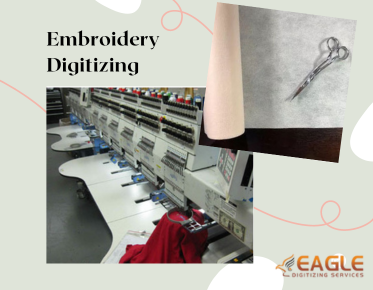Solving The Mystery of Missing Stitches in Machine Embroidery
Machine embroidery can turn ordinary fabrics into works of art, but nothing disrupts a beautiful design like missing stitches. Whether you're a seasoned pro or just starting out, understanding why these gaps happen and how to fix them is crucial. In this article, we'll explore the causes of missing stitches and provide practical solutions to ensure your embroidery projects are always top-notch. Read Here are Some Things That You Should Know When It Comes To Embroidery Digitizing!
Understanding Missing Stitches in Machine Embroidery
Missing stitches occur when the needle fails to catch the bobbin thread, resulting in gaps in the design. This can be frustrating and can ruin an otherwise perfect embroidery piece. Identifying and addressing the causes of missing stitches can save you time and improve the quality of your work.
Why Missing Stitches Matter: Impact on Your Work
Missing stitches can compromise the structural integrity and aesthetic appeal of your embroidery. They can make the design look incomplete and unprofessional. Consistent stitch quality is essential to maintain the durability and visual impact of your embroidered items.
Common Causes of Missing Stitches
Several factors can contribute to missing stitches. Understanding these can help you troubleshoot and prevent issues before they ruin your project.
Incorrect Needle Type and Size
Choosing the Right Needle for Your Fabric
Different fabrics require different needles. For instance, using a ballpoint needle for knits and a sharp needle for wovens ensures that the needle penetrates the fabric correctly without causing damage. The wrong needle type can cause skipped stitches or fabric pulls.
How Needle Size Affects Stitch Quality
The size of the needle should correspond to the thickness of the thread and the fabric. A needle that is too large can leave noticeable holes, while a needle that is too small may struggle to penetrate the fabric, leading to missed stitches. Ensure you're using the correct needle size for your project.
Needle Damage or Wear
Recognizing Signs of a Damaged Needle
A bent or blunt needle can easily cause missed stitches. Regularly inspect your needle for signs of wear, such as burrs, bends, or a dull point. Replace it if you notice any damage.
When to Replace Your Needle
As a rule of thumb, replace your needle after every eight hours of stitching or when switching to a new project with a different fabric. Fresh needles ensure cleaner, more precise stitches.
Improper Thread Tension
Setting the Correct Thread Tension
Thread tension that's too tight or too loose can lead to missing stitches. Adjust the tension settings on your machine to match the thread and fabric you're using. Before beginning your project, test it on a scrap piece of material.
How Tension Issues Lead to Missing Stitches
Incorrect tension can cause the thread to break or slip, resulting in missed stitches. Balanced tension ensures that the top and bobbin threads interlock correctly, creating even and secure stitches.
Thread Quality and Type
Using High-Quality Thread
Cheap or old thread is prone to breaking and can lead to inconsistent stitching. Invest in high-quality thread to ensure smooth and reliable performance.
Matching Thread Type to Your Project
Different threads are suited for different fabrics and designs. Using the correct thread type, whether it's polyester, cotton, or specialty thread, ensures compatibility with your fabric and machine settings.
Bobbin Issues
Proper Bobbin Winding Techniques
Improperly wound bobbins can cause thread tension issues and missed stitches. Ensure your bobbin is wound evenly and with the correct amount of tension.
Identifying and Fixing Bobbin Problems
If your bobbin thread is not feeding smoothly, check for tangles, lint buildup, or incorrect placement. Clean the bobbin case regularly and rethread if necessary.
Machine Timing
Understanding Machine Timing
Machine timing refers to the synchronization of the needle and bobbin. Incorrect timing can cause the needle to miss the bobbin thread, leading to skipped stitches.
How to Adjust Timing for Better Stitches
Consult your machine's manual or a professional technician to adjust the timing. Regular maintenance checks can help keep your machine’s timing in sync.
Fabric Type and Stabilization
Choosing the Right Stabilizer
Stabilizers provide control for the cloth during embroidery, reducing puckering and distortion. Choose the appropriate stabilizer for your fabric type to maintain stitch integrity.
How Fabric Choice Affects Stitch Quality
Different fabrics behave differently under the needle. Lightweight fabrics may need more stabilization, while heavier fabrics might require a stronger needle. Understanding your fabric helps in choosing the right setup.
Hooping Techniques
Properly Hooping Your Fabric
Incorrect hooping can cause fabric slippage, leading to missed stitches. Ensure your fabric is taut and securely hooped to maintain consistent stitch placement.
Avoiding Hooping Mistakes
Avoid over-tightening the hoop, which can distort the fabric, or under-tightening, which can allow the fabric to move. Practice proper hooping techniques for the best results.
Machine Maintenance
Regular Cleaning and Oiling
Dust, lint, and thread buildup can interfere with your machine's operation. Regularly clean and oil your machine according to the manufacturer’s instructions to keep it running smoothly.
How Maintenance Prevents Missing Stitches
A well-maintained machine is less likely to experience issues that cause missing stitches. Routine checks and cleaning can prevent many common problems.
Software and Design Issues
Checking Your Embroidery Design
Poorly digitized designs can lead to missed stitches. Ensure your design files are correctly formatted and optimized for your machine.
Adjusting Software Settings for Better Results
Software settings like stitch density and underlay can affect stitch quality. Adjust these settings to suit your fabric and thread for better embroidery outcomes.
Speed Settings
Optimal Speed for Different Projects
Running your machine at the appropriate speed for the fabric and design can prevent missed stitches. High speeds can cause thread breakage and missed stitches, while lower speeds offer better control.
How Speed Affects Stitch Accuracy
Fast stitching can cause vibration and movement, leading to missed stitches. Adjust your machine speed to balance efficiency and accuracy.
Environmental Factors
Humidity and Temperature Considerations
Extreme humidity and temperature can affect thread tension and fabric behavior. Keep your work environment stable to ensure consistent embroidery results.
How Your Work Environment Impacts Embroidery
A stable environment prevents thread and fabric from reacting unpredictably. Control your workspace conditions for optimal machine performance.
Needle Plate Damage
Inspecting and Replacing the Needle Plate
A damaged needle plate can snag the thread and cause missed stitches. Regularly inspect and replace the needle plate if you notice any wear or damage.
How a Damaged Plate Causes Stitch Issues
Burrs or scratches on the needle plate can disrupt the thread flow, leading to skipped stitches. A smooth needle plate ensures seamless stitching.
Thread Path and Guides
Ensuring a Smooth Thread Path
Check the thread path for any obstructions or misalignments. A smooth thread path reduces friction and prevents missed stitches.
Troubleshooting Thread Guide Problems
Ensure thread guides are correctly positioned and free from debris. Proper threading is essential for consistent stitch quality.
User Error
Common Mistakes and How to Avoid Them
Rushing through setup or ignoring machine guidelines can lead to mistakes. Take your time to follow the proper procedures and settings for your machine.
Importance of Following Machine Guidelines
Adhering to your machine’s guidelines ensures optimal performance. Familiarize yourself with the manual and recommended practices to avoid common errors.
Interfacing and Backing Materials
Choosing the Right Interfacing
Interfacing adds structure and stability to fabrics. Choose the appropriate type and weight for your project to support your stitches.
How Backing Materials Influence Stitch Quality
Backing materials provide additional support and prevent fabric distortion. Use the right backing to maintain stitch consistency.
Using the Right Presser Foot
Selecting the Correct Presser Foot
Different presser feet are designed for different tasks. Using the correct presser foot for your embroidery can improve stitch accuracy and quality.
How Presser Foot Choice Affects Stitches
The right presser foot ensures proper fabric movement and stitch formation. Match the presser foot to your project for the best results.
Testing Before Starting
Running Test Stitches
Always run test stitches on a scrap piece of fabric. This helps you identify and correct any issues before working on the final project.
How Testing Prevents Missing Stitches
Testing allows you to adjust settings and ensure everything is working correctly. It’s a crucial step to prevent missing stitches and ensure quality.
Troubleshooting Techniques
Step-by-Step Troubleshooting Guide
If you encounter missing stitches, follow a systematic approach to identify and fix the problem. Check needles, thread, tension, and machine settings in a logical order.
Quick Fixes for Common Problems
Many issues can be resolved with simple adjustments, like changing the needle or rethreading the machine. Familiarize yourself with common fixes to save time.
Professional Tips and Tricks
Expert Advice for Perfect Stitches
Learn from the pros. Experienced embroiderers often have valuable tips and tricks to achieve perfect stitches. Seek out expert advice and incorporate it into your routine.
How to Minimize Missing Stitches in Your Work
Consistency is key. Regular maintenance, proper setup, and careful attention to detail can minimize missing stitches and improve your overall embroidery quality.
Missing stitches can be caused by various factors, from needle issues to environmental conditions. Understanding these causes and implementing solutions can greatly enhance your embroidery projects.
Achieving flawless embroidery is a combination of using the right tools, maintaining your machine, and paying attention to detail. With the right knowledge and practice, you can create stunning, professional-quality embroidery every time.



